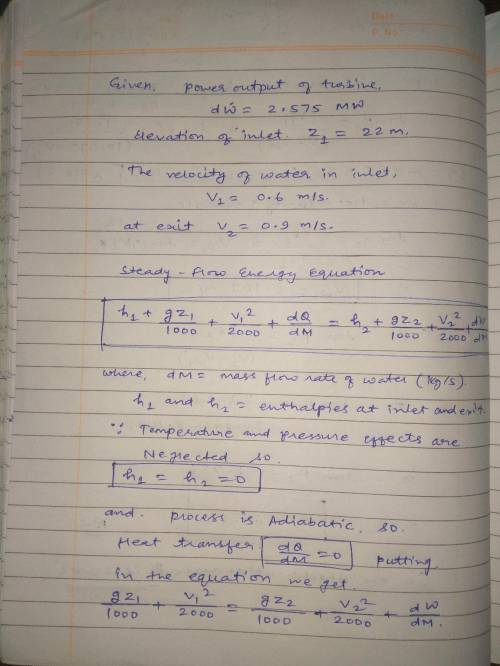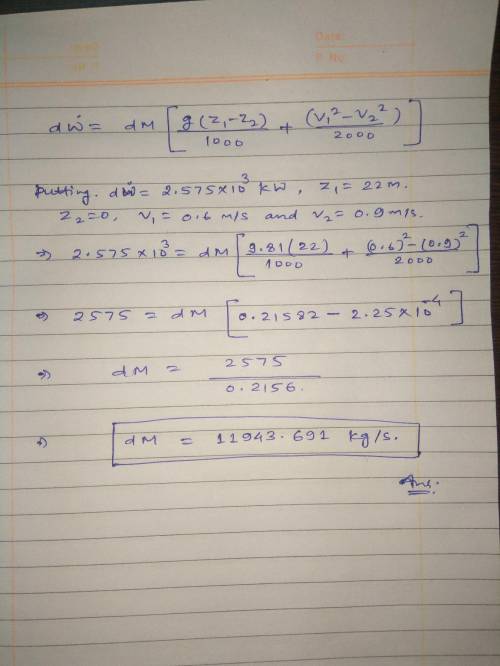
Engineering, 15.04.2020 23:20 BIGJAYWESTSIDE
Niagara Falls is capable of producing a total power output of 2.575 MW at steady-state during the night when flow over the falls is diverted through a hydroelectric turbine. This is done at night so as not to detract from tourism during the daytime. Changes in temperature and pressure of the flow through the turbine are negligible. The intake to the turbine is located at the top of Niagara River and exits at the bottom of the falls, 22 m below. The velocity of the water in the penstock upstream of the turbine is, on average, 0.6 m/s and exits the turbine, operating adiabatically, at 0.9 m/s. - What is the mass flow rate of water through the turbine at night, in kg/s?

Answers: 2
Another question on Engineering

Engineering, 04.07.2019 18:10
Abrake has a normal braking torque of 2.8 kip in and heat-dissipating cast-iron surfaces whose mass is 40 lbm. suppose a load is brought to rest in 8.0 s from an initial angular speed of 1600 rev/min using the normal braking torque; estimate the temperature rise of the heat dissipating surfaces.
Answers: 3

Engineering, 04.07.2019 18:10
Asingle-geared blanking press has a stroke of 200 mm and a rated capacity of 320 kn. a cam driven ram is assumed to be capable of delivering the full press load at constant force during the last 15 percent of a constant-velocity stroke. the camshaft has an average speed of 90 rev/min and is geared to the flywheel shaft at a 6: 1 ratio. the total work done is to include an allowance of 16 percent for friction a) estimate the maximum energy fluctuation b) find the rim weight for an effective diameter of 1.2 m and a coefficient of speed fluctuation of 0.10
Answers: 1

Engineering, 04.07.2019 18:10
Apipe with an outside diameter of 15 cm is exposed to an ambient air and surrounding temperature of -20°c. the pipe has an outer surface temperature of 65°c and an emissivity of 0.85. if the rate of heat loss from the pipe surface is 0.95 kw per meter of length, the external convective heat transfer coefficient (h) is: (a) 12.5 w/m"k (b) 18.6 w/mk (c) 23.7 w/mk (d) 27.9 w/mk (e) 33.5 w/mk
Answers: 1

Engineering, 04.07.2019 18:10
Burgers vector is generally parallel to the dislocation line. a)-true b)-false
Answers: 2
You know the right answer?
Niagara Falls is capable of producing a total power output of 2.575 MW at steady-state during the ni...
Questions

Biology, 01.01.2020 14:31

History, 01.01.2020 14:31



Social Studies, 01.01.2020 14:31

Mathematics, 01.01.2020 14:31

Mathematics, 01.01.2020 14:31


Mathematics, 01.01.2020 14:31





Mathematics, 01.01.2020 14:31




History, 01.01.2020 14:31






